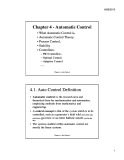
ISSN: 2615-9740
JOURNAL OF TECHNICAL EDUCATION SCIENCE
Ho Chi Minh City University of Technology and Education
Website: https://jte.edu.vn
Email: jte@hcmute.edu.vn
JTE, Volume 19, Special Issue 05, 2024
31
Adaptive Proportional-Integral Control Design for a Class of Continuous Stirred
Tank Reactors with Uncertain Parameters
Thanh Sang Nguyen1, Ngoc Ha Hoang2*
1Ho Chi Minh City University of Technology and Education, Vietnam
2Duy Tan University, Da Nang, Vietnam
*Corresponding author. Email: ngocha.h@gmail.com
ARTICLE INFO
ABSTRACT
Received:
30/04/2024
Mathematical model of reaction systems contains experimental parameters
such as reaction enthalpies, which may be inaccurate and, therefore,
severely affect the computation as well as the implementation of feedback
control laws. This paper aims to design an adaptive PI-like controller to
regulate a chemical reaction system by means of the Lyapunov theory. More
precisely, uncertain model parameters are updated online by solving a set of
ordinary differential equations while the global asymptotic convergence of
closed-loop system trajectories towards the desired equilibrium is ensured
by using the proposed adaptive PI-like controller under the assumption of
stability of isothermal conditions. The applicability of theoretical
developments is illustrated with an irreversible first-order reaction system
having multiple steady states and taking place in a non-isothermal
continuous stirred tank reactor. Simulation results show that system
trajectories initiated at different conditions are asymptotically stabilized at
the desired values and the closed-loop system is robust against the
uncertainty of heat exchange coefficient and dilution rate.
Revised:
28/07/2024
Accepted:
06/08/2024
Published:
28/12/2024
KEYWORDS
Chemical reactor;
Temperature regulation;
Control theory;
Lyapunov function;
Non-isothermal reactor.
Doi: https://doi.org/10.54644/jte.2024.1570
Copyright © JTE. This is an open access article distributed under the terms and conditions of the Creative Commons Attribution-NonCommercial 4.0
International License which permits unrestricted use, distribution, and reproduction in any medium for non-commercial purpose, provided the original work is
properly cited.
1. Introduction
From the viewpoint of mathematical modeling, the dynamics of continuous stirred tank reactors
(CSTR), including material and energy balance equations, can be described by a set of ordinary
differential equations (ODEs) [1], [2] and affected not only by reaction kinetics but also by transport
phenomena with the presence of inlet and outlet streams, thereby giving rise to typical nonlinear
behaviors such as input/output multiplicity, non-minimum phase behavior or limit cycle [3], [4]. In
practice, these behaviors possibly cause the internal instability and restrict the nonlinear chemical
processes themselves to achieve the desirable performance [5]-[7].
Figure 1. Van Heerden diagram of a first-order exothermic reaction system














